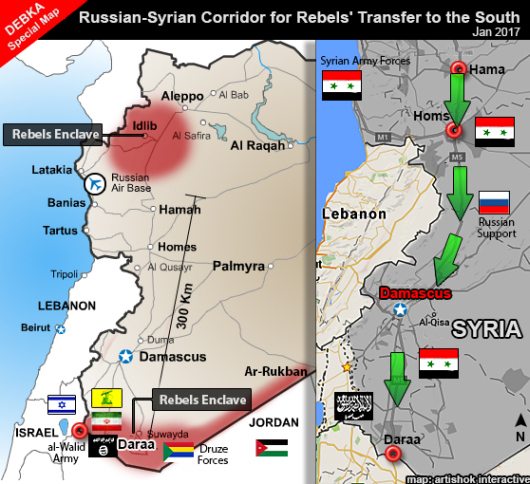Putin Charts Mass-Transfer of Rebels from Central Syria to the South
Russian President Vladimir Putin is getting set for the second chapter of his ambitious program for shifting masses of rebels to Syrian borderlands.
Two weeks ago, some 35,000 defeated rebels and their families were evacuated from eastern Aleppo and transported to Idlib in the north for resettlement.
(See DEBKA Weekly 735 of Dec. 9: Idlib on Hot Plate after Aleppo.)
The next chapter of this mass-transfer will be more challenging. DEBKA Weekly’s military and intelligence sources reveal that it entails the transfer of nearly double this number of rebel fighters from central Syria for relocation in southern enclaves similar to Idlib around the provincial town of Daraa.
These wholesale population shifts are designed to restore the authority of Bashar Assad’s government under Russian protection to areas regained from rebel hands.
To overcome potential roadblocks to Part II of the program, Russian intelligence officers based in Tel Aviv and Amman have sent out feelers to test Israeli and Jordanian reactions to the prospect of tens of thousands of Syrian rebel fighters from Homs, Hama and Damascus being resettled on their doorsteps.
This project was the subject of the last phone conversation between President Putin and Israeli Prime Minister Binyamin Netanyahu on Dec. 31, their second in a week.
The statement from the prime minister’s office in Jerusalem said the two leaders talked about regional developments “with an emphasis on Syria and a continuation of security coordination on that front that has already proven itself in the prevention of misunderstandings between the Russian and Israeli armies.”
Our sources have gained access to the main points of the plan Moscow put before Jerusalem and Amman (as illustrated by the attached map).
- The Russian and Syrian armies will monitor a 285km-long military corridor for the transport of 50,000-80,000 rebels from a departure point in Hama to Daraa.
- The two armies will guarantee their safe passage. Like the evacuees from Aleppo, they will be accompanied by their families and be driven to their new homes by buses provided by the Syrian government,
- Iranian Revolutionary Guards and Hizballah forces positioned in Daraa and close to the Amman-Damascus highway will move out in the opposite direction to destinations in central Syria.
- Two problems remain to be solved:
a) The disposition of the large Syrian refugee camp of Ar-Rukbah, holding some 100,000 inmates in southern Syria on the Jordanian border. It is feared in Amman that rebel groups will try on arrival to commandeer the camp and make it their southern stronghold. Jordan’s King Abdullah sees this as a major threat to the northern part of his realm.
b) The Russians have not worked out how to clear armed Islamic groups out of the new southern enclaves on the Syrian borders with Jordan and Israel, especially the Khalid Bin Al-Walid Army which has pledged allegiance to the Islamic State and the Nusra Front in western Daraa, Jordan’s archenemy. - The Russians are working hard to allay concerns in Jerusalem and Amman about the planting of a huge mass of Syrian rebel fighters on their borders. They argue that a combination of Jordan’s ground forces, Israel’s advanced intelligence capacity and international humanitarian assistance are a match for any peril the new settlers may pose.
And anyway, the beaten insurgents are no longer organized in fighting groups like ISIS and Nusra, but are ready to settle down, say the Russian lobbyists. With a small outlay of cash and assistance, they can be persuaded to build new homes and lives.
The bilateral military coordination mechanisms already working in Syria for Russia, Israel and Jordan will be responsible for supervising and coordinating this plan - Moscow has kept Washington out of its rebel resettlement program and refrained from bringing to the notice of the Obama administration.
Summing up the Russian program, DEBKA Weekly’s military sources assert that its main object is to cleanse central and western Syria of all rebel forces and bring those regions under full Russian and Syrian government control. The rebels will be boxed into two enclaves at the northern and southern extremities of the country.
The northern enclave will be monitored by Turkish armed forces and intelligence, while the southern pockets will come under the purview of the Israeli and Jordanian arms and their intelligence agencies.


